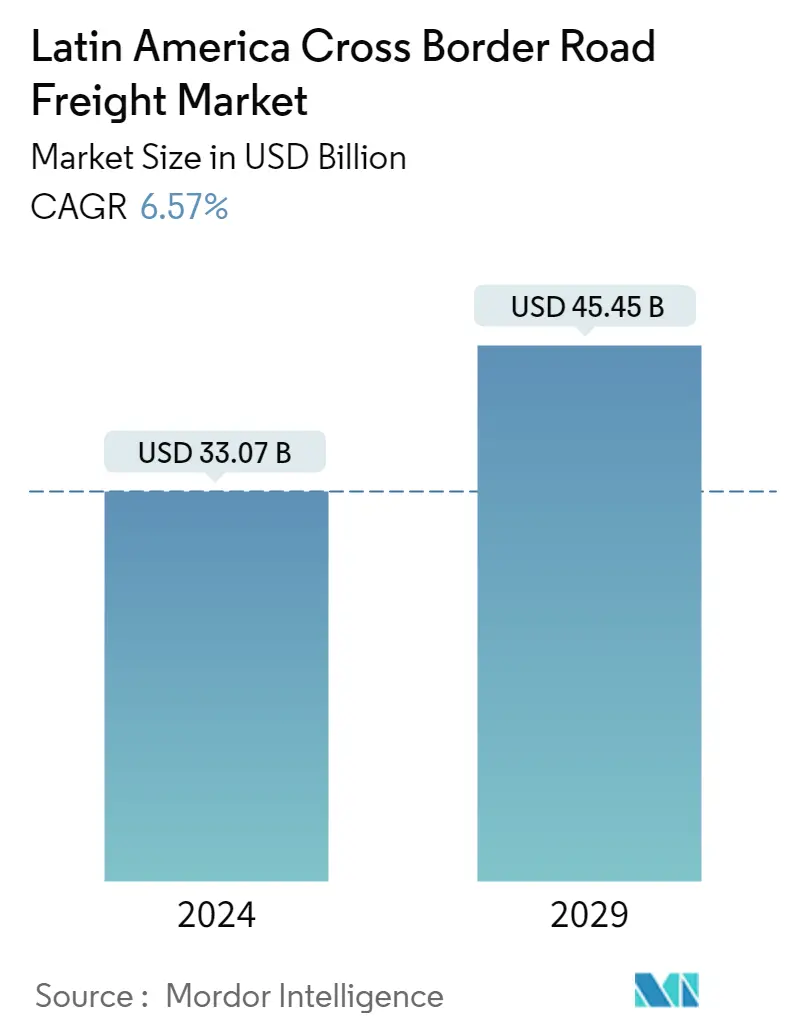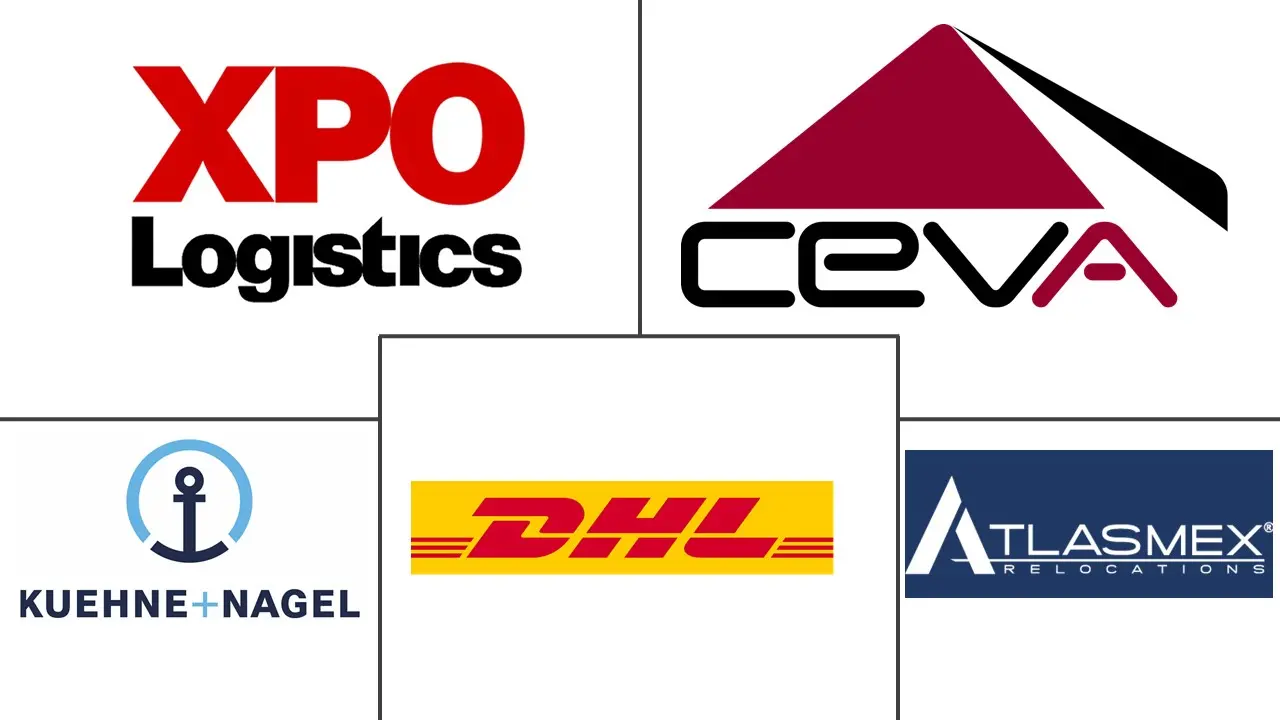Market Size of Latin America Cross Border Road Freight Industry

| Study Period | 2020 - 2029 |
| Base Year For Estimation | 2023 |
| Market Size (2024) | USD 33.07 Billion |
| Market Size (2029) | USD 45.45 Billion |
| CAGR (2024 - 2029) | 6.57 % |
| Market Concentration | High |
Major Players
*Disclaimer: Major Players sorted in no particular order |
Latin America Cross Border Road Freight Market Analysis
The Latin America Cross Border Road Freight Market size is estimated at USD 33.07 billion in 2024, and is expected to reach USD 45.45 billion by 2029, growing at a CAGR of 6.57% during the forecast period (2024-2029).
The market is experiencing increasing investments in shipping and trucking segments with the increasing demand for perishable goods and oil and gas. B2C-related cross-border deals have also been strong in this growing stream of Latin America. The imaginations of blue-water regions such as Mexico, Chile, and Brazil are expanding across the world's e-commerce landscape.
Land freight transport in Latin America is the most important mode of transportation for the region's subsystems of production, distribution, and sustainable development executing national and international merchandise distribution logistics. However, the poor road infrastructure in the region is a major limitation to the growth of the segment.
Latin America Cross Border Road Freight Industry Segmentation
Cross border road freight refers to transportation activities, infrastructures, and flows that support the passage of freight across an international border through roads as its mode of transportation.
The report provides a comprehensive background analysis of the cross border road freight market, covering the current market trends, restraints, technological updates and detailed information on various segments, and the competitive landscape of the industry. The impact of COVID-19 has also been incorporated and considered during the study.
The Latin American cross border road freight market is segmented by function (FTL, LTL, and CEP), end user (manufacturing and automotive, oil and gas, chemicals, agriculture, fishing, and forestry, construction, distributive trade, pharmaceutical and healthcare, and other end users (telecommunications, food and beverage, etc.), and geography (Mexico, Brazil, Panama, Chile, Colombia, and Rest of Latin America).
| By Function | |
| Full Truck Load (FTL) | |
| Less than Truck Load (LTL) | |
| Courier, Express, and Parcel (CEP) |
| By End User | |
| Chemicals | |
| Agriculture, Fishing, and Forestry | |
| Construction | |
| Distributive Trade | |
| Pharmaceutical and Healthcare | |
| Manufacturing and Automotive |
| By Geography | |
| Mexico | |
| Brazil | |
| Argentina | |
| Chile | |
| Colombia | |
| Rest of Latin America |
Latin America Cross Border Road Freight Market Size Summary
The Latin America cross-border road freight market is poised for significant growth, driven by increasing investments in shipping and trucking sectors. This growth is largely fueled by the rising demand for perishable goods and the oil and gas industry, with countries like Brazil, Mexico, and Venezuela playing pivotal roles in oil production. These nations are not only leading in regional output but also hold significant positions in the global oil market. Despite challenges such as inadequate road infrastructure, the region's land freight transport remains crucial for national and international logistics, supporting the production, distribution, and sustainable development subsystems. The expansion of e-commerce in countries like Mexico, Chile, and Brazil further underscores the market's potential, particularly in B2C cross-border transactions.
The market's expansion is also supported by the burgeoning food and beverage industry, with Latin America being a top producer of fresh fruits, vegetables, and various meats. The demand for refrigerated transport is on the rise, driven by globalization and the increasing consumption of ready-to-eat and frozen foods. While the investment in refrigerated trailers is higher compared to vans and trucks, local players tend to favor the latter due to cost considerations. The market is characterized by a mix of local and international players, with companies like DHL, Ceva Logistics, and Atlasmex actively expanding their services through strategic mergers and acquisitions. Recent developments, such as OOCL Logistics' establishment of a flagship office in Costa Rica and GEFCO's partnership with Foton Motor Group in Brazil, highlight the ongoing efforts to enhance operational efficiencies and expand market reach.
Latin America Cross Border Road Freight Market Size - Table of Contents
-
1. MARKET DYNAMICS AND INSIGHTS
-
1.1 Current Market Scenario
-
1.2 Market Dynamics
-
1.2.1 Drivers
-
1.2.2 Restraints
-
1.2.3 Opportunities
-
-
1.3 Value Chain/Supply Chain Analysis
-
1.4 Government Regulations, Trade Agreements, and Initiatives
-
1.5 Technological Developments in the Logistics Sector
-
1.6 Insights into the Transportation Costs, Transit Times, and Costs Associated with Border Crossing in Key Routes
-
1.7 Insights into Cross border E-commerce (B2C and B2C)
-
1.8 Insights into Rules and Regulations at Key Border Crossing Points (Customs, Licensing, Duties and Taxes, etc.)
-
1.9 Industry Attractiveness - Porter's Five Forces Analysis
-
1.10 Impact of COVID-19 on the Market
-
-
2. MARKET SEGMENTATION
-
2.1 By Function
-
2.1.1 Full Truck Load (FTL)
-
2.1.2 Less than Truck Load (LTL)
-
2.1.3 Courier, Express, and Parcel (CEP)
-
-
2.2 By End User
-
2.2.1 Chemicals
-
2.2.2 Agriculture, Fishing, and Forestry
-
2.2.3 Construction
-
2.2.4 Distributive Trade
-
2.2.5 Pharmaceutical and Healthcare
-
2.2.6 Manufacturing and Automotive
-
-
2.3 By Geography
-
2.3.1 Mexico
-
2.3.2 Brazil
-
2.3.3 Argentina
-
2.3.4 Chile
-
2.3.5 Colombia
-
2.3.6 Rest of Latin America
-
-
Latin America Cross Border Road Freight Market Size FAQs
How big is the Latin America Cross Border Road Freight Market?
The Latin America Cross Border Road Freight Market size is expected to reach USD 33.07 billion in 2024 and grow at a CAGR of 6.57% to reach USD 45.45 billion by 2029.
What is the current Latin America Cross Border Road Freight Market size?
In 2024, the Latin America Cross Border Road Freight Market size is expected to reach USD 33.07 billion.

